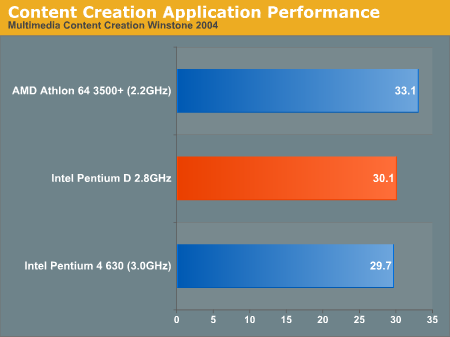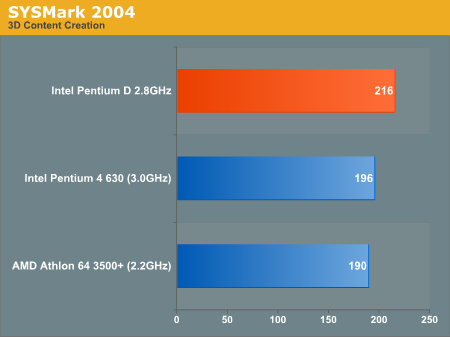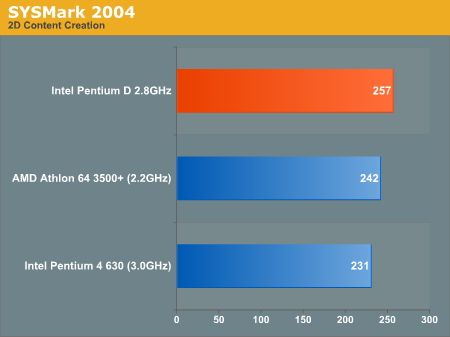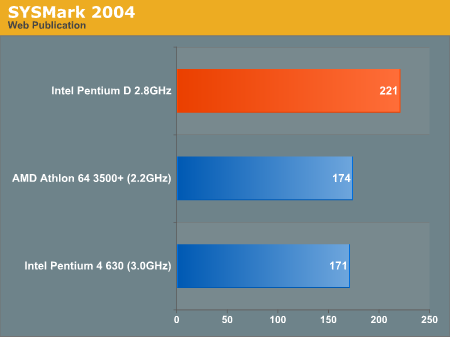Intel Dual Core Performance Preview Part II: A Deeper Look
by Anand Lal Shimpi on April 6, 2005 12:23 PM EST- Posted in
- CPUs
Multimedia Content Creation Performance
MCC Winstone 2004
Multimedia Content Creation Winstone 2004 tests the following applications in various usage scenarios:
- Adobe® Photoshop® 7.0.1
- Adobe® Premiere® 6.50
- Macromedia® Director MX 9.0
- Macromedia® Dreamweaver MX 6.1
- Microsoft® Windows MediaTM Encoder 9 Version 9.00.00.2980
- NewTek's LightWave® 3D 7.5b
- SteinbergTM WaveLabTM 4.0f
All chips were tested with Lightwave set to spawn 4 threads.

Once again, AMD's 3500+ takes the lead in the MCC tests, despite the benefits of dual core in the area.
ICC SYSMark 2004
The first category that we will deal with is 3D Content Creation. The tests that make up this benchmark are described below:
"The user renders a 3D model to a bitmap using 3ds max 5.1, while preparing web pages in Dreamweaver MX. Then the user renders a 3D animation in a vector graphics format."

Next, we have 2D Content Creation performance:
"The user uses Premiere 6.5 to create a movie from several raw input movie cuts and sound cuts and starts exporting it. While waiting on this operation, the user imports the rendered image into Photoshop 7.01, modifies it and saves the results. Once the movie is assembled, the user edits it and creates special effects using After Effects 5.5."

The Internet Content Creation suite is rounded up with a Web Publishing performance test:
"The user extracts content from an archive using WinZip 8.1. Meanwhile, he uses Flash MX to open the exported 3D vector graphics file. He modifies it by including other pictures and optimizes it for faster animation. The final movie with the special effects is then compressed using Windows Media Encoder 9 series in a format that can be broadcast over broadband Internet. The web site is given the final touches in Dreamweaver MX and the system is scanned by VirusScan 7.0."

SYSMark shows the exact opposite with the Pentium D taking the lead in all three of the ICC tests.










106 Comments
View All Comments
JoKeRr - Wednesday, April 6, 2005 - link
the power consumption is a series mofo here.hm, with a P4 EE or PDEE, with 2 6800Ultra or GT, you're definitely expecting an oven case.
Wonder how those dualcores overclock-->that should help to make up the single thread performance. On the other hand, Clearly HyperThreading is GOOD, but AMD still says NO.
Jeff7181 - Wednesday, April 6, 2005 - link
Great article. Well done guys.The only thing I have to question is how a dual core Athlon-64 at encoding. On the last page you say, "For encoding performance, you still can’t beat the Pentium D. Even a dual core Athlon 64 isn’t going to help enough in that area."
What makes you think that when the 2.2 GHz Athlon-64 is RIGHT behind the 3.0 GHz Pentium 4 630?
Everything I've read so far has told me that the Athlon-64 should scale better than the Pentium 4 as far as dual cores are concerned... so... what exactly are you basing your opinion that even a dual core Athlon-64 won't help in encoding???
Lonyo - Wednesday, April 6, 2005 - link
Does http://www.anandtech.com/cpuchipsets/showdoc.aspx?... page have an error?It lists the PD 3.2, P4 3.73 EE and the PD 3.2 EE, not the 3 CPU's montioned in the article. Wrong graph maybe.
Rys - Wednesday, April 6, 2005 - link
H isn't even near P on the keyboard...michaelpatrick33 - Wednesday, April 6, 2005 - link
Holy crispy power and cook my eggs in true multitasking while I surf the net Batmansmn198 - Wednesday, April 6, 2005 - link
I guess it makes sense that NCQ would help when multitasking. I assume that this would be the same on single cores as well? The new focus on responsiveness is a good move IMO. The time to switch between apps and redraw the screen and clicking on menus and buttons is what frustrates me when I am multitasking.